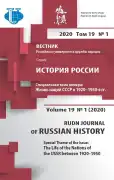Comrades in Arts: The Soviet Dekada of National Art and the Friendship of Peoples
- 作者: Kaplan I.R.1
-
隶属关系:
- National Research University Higher School of Economics
- 期: 卷 19, 编号 1 (2020): THE LIFE OF THE NATIONS OF THE USSR BETWEEN 1920-1950
- 页面: 78-94
- 栏目: THE LIFE OF THE NATIONS OF THE USSR BETWEEN 1920-1950
- URL: https://journal-vniispk.ru/2312-8674/article/view/321852
- DOI: https://doi.org/10.22363/2312-8674-2020-19-1-78-94
- ID: 321852
如何引用文章
全文:
详细
This article examines the dekady of national art, a series of Soviet festivals fi rst staged in the mid-1930s to highlight the cultures and artistic accomplishments of the various non-Russian republics of the USSR. The institution of the dekada, I contend, made considerable contributions to Soviet nationbuilding eff orts and the construction of multiethnic culture. The article unfolds in three sections. The fi rst relies on archival documents to trace the origins and evolution of the dekada of national art in the context of its bureaucratic home, the All-Union Committee on Arts Aff airs. The second draws largely on periodical sources to consider the ways in which the larger currents of Stalin-era culture are refl ected in the dekady of national art and, in particular in the national operas that served as the centerpieces of the dekady. The fi nal section turns to the Friendship of Peoples campaign, identifying one aspect of it - that Soviet citizens appreciate not only their own national art but the art of other Soviet nations - as central to the dekady. Analyzing the public rhetoric surrounding the dekady, I identify several themes that emerge and their implications for forging a common pan-Soviet culture. I conclude that it is not only national cultural production, but the consumption of national cultural products by a multiethnic audience that is central to nation-building on multiple levels as well as a means to unite the ethnically diverse Soviet people, and that the dekada festivals aimed to bring the Soviet nations closer together by providing them an opportunity to consume one another’s cultural products.
作者简介
Isabelle Kaplan
National Research University Higher School of Economics
编辑信件的主要联系方式.
Email: kaplanindc@yahoo.com
PhD in History, Post-Doctoral Fellow, International Centre for the History and Sociology of World War II and Its Consequences
21/4, Staraya Basmannaya St., Moscow, 105066 Russia参考
- Brooks, Jeff rey. Thank You, Comrade Stalin! Soviet Public Culture from Revolution to Cold War. Princeton, NJ: Princeton University Press, 2000.
- Dobrenko, Evgenii. “Naideno v perevode: rozhdenie sovetskoi mnogonatsional’noi literatury iz smerti avtora.” Neprikosnovennyi zapas, no. 4 (July - August 2011): 236-262 (in Russian).
- Dumitru, Diana, and Johnson, Carter. “Constructing Interethnic Confl ict and Cooperation: Why Some People Harmed Jews and Others Helped Them during the Holocaust,” World Politics 61, no. 1 (January 2011): 1-42.
- Dzhanaliev, K. Iskusstvo Sovetskoi Kirgizii. Moscow: Iskusstvo, 1939 (in Russian).
- Fowler, Mayhill C. Beau Monde on Empire’s Edge: State and Stage in Soviet Ukraine. Toronto: University of Toronto Press, 2017.
- Frolova-Walker, Marina. “ ‘National in Form, Socialist in Content’: Musical Nation-Building in the Soviet Republics.” Journal of the American Musicological Society 51, no. 2 (Summer 1998): 331-371.
- Frolova-Walker, Marina. “The Soviet Opera Project: Ivan Dzerzhinsky vs. Ivan Susanin.” Cambridge Opera Journal 18, no. 2 (July 2006): 181-216.
- Kaplan, Isabelle R. The Art of Nation-building: National Culture and Soviet Politics in Azerbaijan and Other Minority Republics. PhD diss., Georgetown University, 2017.
- Kotkin, Stephen. Magnetic Mountain: Stalinism as Civilization. Berkeley, CA: University of California Press, 1995.
- Martin, Terry. The Affirmative Action Empire: Nations and Nationalism in the Soviet Union, 1923-1939. Ithaca, NY: Cornell University Press, 2001.
- Moisenko, Rena. Realist Music: 25 Soviet Composers. London: Meridian Books, 1949.
- Petrone, Karen. Life Has Become More Joyous, Comrades: Celebrations in the Time of Stalin. Bloomington, IN: Indiana University Press, 2000.
- Shaw, Matthew. Time and the French Revolution: A History of the French Republican Calendar, 1789-Year XIV. Woodbridge, UK: The Boydell Press, 2011.
- Siegelbaum, Lewis H. Stakhanovism and the Politics of Productivity in the USSR, 1935-1941. New York: Cambridge University Press, 1988.
- Slezkine, Yuri. “The USSR as a Communal Apartment, or How a Socialist State Promoted Ethnic Particularism.” Slavic Review 53, no. 2 (Summer 1994): 414-52.
- Yekelchyk, Serhy. “Diktat and Dialogue in Stalinist Culture: Staging Patriotic Historical Opera in Soviet Ukraine, 1936-1954.” Slavic Review, No. 59/3 (Autumn 2000): 597-624.
补充文件









